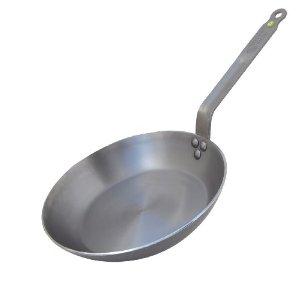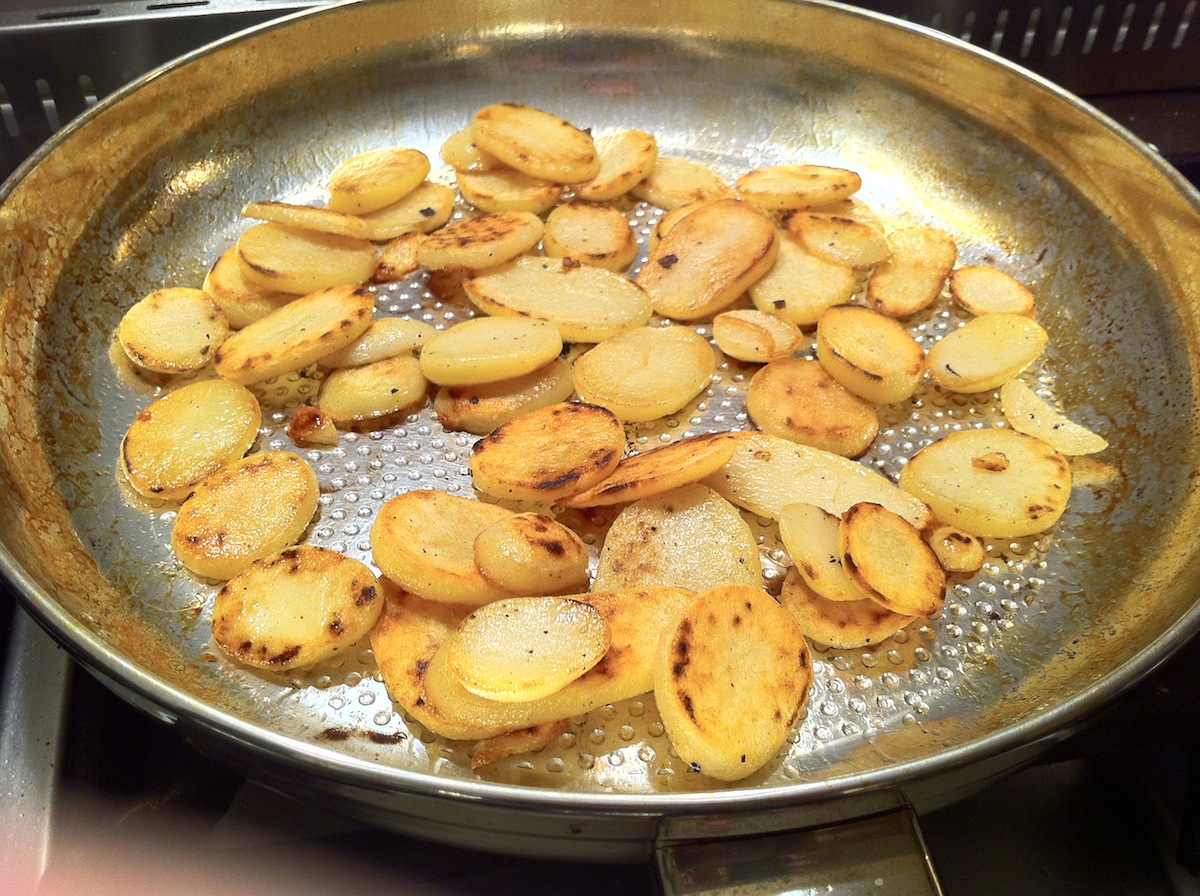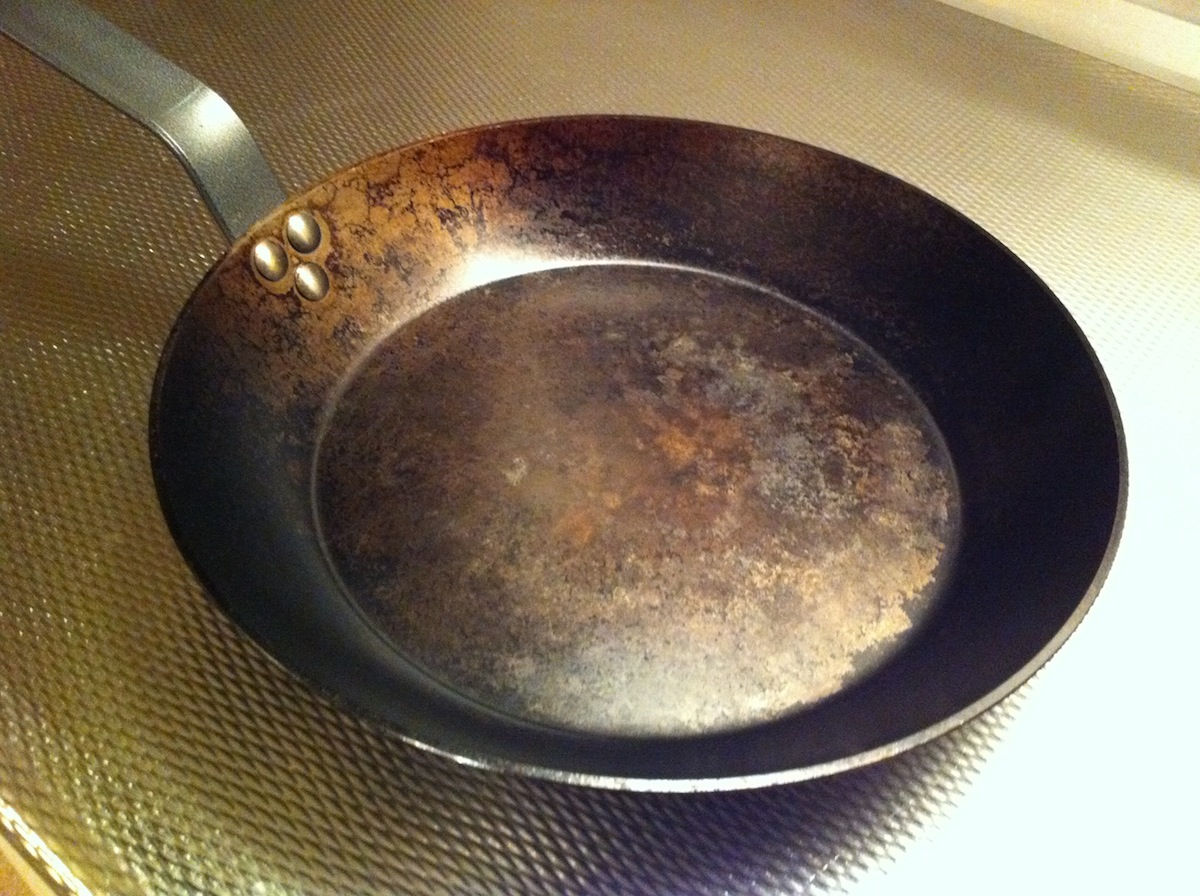The Pan Rant
 You may have seen recent tweets from me ranting about my frying pans. I've ruined a few (very expensive) pans and replaced them with dirt-cheap pans which are actually much better. I would like to share my experiences and solutions with you, so that you can buy the right (cheap) pan without having to go through the same thing. Links to all the pans are in the article below.
You may have seen recent tweets from me ranting about my frying pans. I've ruined a few (very expensive) pans and replaced them with dirt-cheap pans which are actually much better. I would like to share my experiences and solutions with you, so that you can buy the right (cheap) pan without having to go through the same thing. Links to all the pans are in the article below.
After a few years, the large Calphalon pan started to show some black stains on the rim, and I wanted to clean those. I regularly clean the pans with abrasive sponges, but this black stuff wouldn't come off. In a strange (and stupid) last effort to clean it, I sprayed the large pan with oven cleaner. The aluminum started oxidizing, and the pan was ruined. I was pretty upset, but luckily I did it with just one pan (albeit the most expensive one).
 Off to the store I went, but this time with a smaller budget. I bought a nice and shiny polished aluminum BK frying pan for €30,- . I used it for a few days and very quickly the pan had some brown spots on the rim of the pan. Being polished aluminum, I could not use abrasive sponges here. So I tried all kinds of tricks from this "grandma's advice" website without the desired results. The last tip I tried was to kook some washing detergent in it, which should dissolve the brown grease. It did not. Instead, it ruined the pan completely.
Off to the store I went, but this time with a smaller budget. I bought a nice and shiny polished aluminum BK frying pan for €30,- . I used it for a few days and very quickly the pan had some brown spots on the rim of the pan. Being polished aluminum, I could not use abrasive sponges here. So I tried all kinds of tricks from this "grandma's advice" website without the desired results. The last tip I tried was to kook some washing detergent in it, which should dissolve the brown grease. It did not. Instead, it ruined the pan completely.
Frustrated by the fact that nobody in the world (or at least on "the internets") seemed to have pan cleaning problems or answers, I started looking for different alternatives.
Some googling shows that most professional restaurants use rolled steel pans, without any coating. Just plain steel. This is actually pretty funny, when you think about the expensive Teflon and Ceramic coated pans in the stores for well over €30,- while professional cooks use steel pans of around €20,- which survive many years of heavy use and actually become better and better over time. Professional cooks mostly use gas as heat source, but steel pans can be used on any heat source, even on induction stoves.
I already have a rolled steel wok, and am very happy with that, so I decided to get a rolled steel "De Buyer" frying pan at kookman.nl. I ordered it on a Saturday, and on Sunday they mailed me that didn't have the 26cm pan and offered to send me the 30cm for the same price. That sounded like a good deal so that's what I received on my doorstep on Tuesday. Very good service.
Before doing any cooking, you have to prepare the pan in order to keep the meat from sticking to the steel. This is called "seasoning the pan" and is really easy to do: Heat the pan, then add oil, and fry some salt in it. There are different methods but salt blackens the pan quicker, I like that. The good thing about a steel pan is that if you screw it up, you can practically sand it down with your abrasive sponge and try again. and again. and again.
 Here you see my de Buyer pan after seasoning and a few evenings of cooking. This is how your clean pan should look. Washing a non-coated steel pan is generally done without detergent, under extremely hot water with a brush. This keeps the dark "nonstick coating" in the pan. The pans will become darker upon use.
Here you see my de Buyer pan after seasoning and a few evenings of cooking. This is how your clean pan should look. Washing a non-coated steel pan is generally done without detergent, under extremely hot water with a brush. This keeps the dark "nonstick coating" in the pan. The pans will become darker upon use.
If you leave the pan dirty overnight, the grease will sometimes come off, or it will start to rust. Don't worry, scrub it and re-season it and you have a new pan.
My new steel frying pan will probably outlast me and my kids. And if I can keep the small Calphalon pan away from the oven cleaner, it may do the same thing.
 So that's the pan story. But I hear you ask "Why all this trouble? Why not buy a Teflon pan?" Here's why: I don't trust it to be healthy. Teflon is one of the scariest polymers out there, and anybody knows how Teflon coating degrades, leaving little pieces of Teflon in your food.
So that's the pan story. But I hear you ask "Why all this trouble? Why not buy a Teflon pan?" Here's why: I don't trust it to be healthy. Teflon is one of the scariest polymers out there, and anybody knows how Teflon coating degrades, leaving little pieces of Teflon in your food.
If you search around for the chemical properties of Teflon, you will find some interesting facts. Meat is usually fried between 200 and 230 °C. The thermochemical decomposition of PTFE (Teflon) is detectable at 200 °C. If you ever wondered why your canary died early, the degradation by-products can be lethal to birds.
PFOA is used in the production process of PTFE coated pans to reduce surface tension. Tests with PFOA on laboratory animals showed increased risk of cancer. Recently higher serum levels of PFOA were found to be associated with increased risk of chronic kidney disease in the general United States population. This is consistent with earlier animal studies. It is also recently linked to Arthritis. PFOA is a carcinogen, liver toxicant, a developmental toxicant, an immune system toxicant, and also exerts hormonal effects including alteration of thyroid hormone levels.
Recently, several manufacturers have started selling pans with ceramic coatings and put "PTFE Free" and "PFOA Free" labels on these pans. Why do you think they did that? Maybe it's because PTFE and PFOA aren't all that healthy after all. And apart from the coating in your pan, the production process of PTFE and PFOA is very, very bad for the environment. Ask Dupont.
As it turns out, if you know how to treat a pan, the best coating is no coating at all. It's not only healthier and better for the environment, but top chefs will tell you it actually makes your food taste better. Next time you are in an expensive restaurant, ask what pans they use. You'd be surprised.